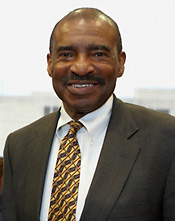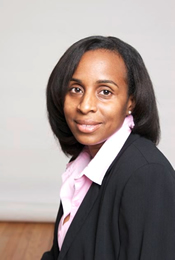With a continued mission to enroll more students from underrepresented school districts, the Academic Bridge Program (ABP) begins its second decade at UT Dallas. In that time, not only has it doubled in size, but it also has created a formula for graduation success.
“We began the program 10 years ago with 30 students,” said Dr. George W. Fair, dean of the School of Interdisciplinary Studies and head of the ABP. “All along, we’ve maintained a graduation rate of more than 70 percent. Thanks to AT&T’s generous gift of $220,000 this year, we’ve increased our enrollment to 60.”
In return, Fair and his staff have increased their focus on science, technology, engineering and mathematics (STEM) students. Twenty-two students in this year’s incoming ABP class plan to major in engineering and computer science. “We’re preparing students for the 21st century,” Fair said. “Not only is it more a technologically demanding world, it’s more diverse.”

“Even though our program is groundbreaking, we haven’t invented anything,” Dean George Fair said.
That diversity is what inspired him to begin the program in the first place.
“We started off in the summer of 2000 with the idea that The University of Texas at Dallas, by its very name, represents the fourth-largest metropolitan area in the country,” Fair said. “We took a look at the number of students from the Dallas Independent School District (DISD) who were enrolled here.”
Just as they suspected, enrollment was far less than what a representative population of that sample should be. “We asked, ‘What can we do to begin a program that would encourage more DISD students to come to our University and support them throughout their academic careers?’” Fair said. “We obtained funding through the state Legislature as a result of Rep. Helen Giddings’ hard work and launched the Academic Bridge Program.”
The plan was simple and groundbreaking at the same time: Take the time, attention, effort and additional resources required to transition students from an academic environment that often wasn’t able to provide them with the resources necessary to make them college-ready, and get them ready in a few short weeks.
“Even though our program is groundbreaking, we haven’t invented anything,” Fair said. “We have, however, taken some additional resources and committed personnel and created an atmosphere where the concept can survive. We think we’ve been successful.
“For the most part, our students come in with an SAT score that is 200 points less than that of the entering freshman class. We provide the support, encouragement and necessary essentials which enable them to graduate at a rate that is almost 10 percent higher than the University average.”

“When students see that we care – that we’re concerned about them – then they begin to understand that we’re different from other recruiters,” says project supervisor Cornelia McCowan.
Part of that formula is the ABP’s demanding selection process – one that seeks students who are committed, have the confidence and the willingness to think about their future and who want to get a degree. Still, the most promising students, like incoming freshman Robert Martin, can feel overwhelmed by the sheer complexity of navigating their new collegiate environment.
“There have been a lot of stressful times and happy times,” Martin said. “Overall though, my ABP experience has been definitely rewarding. The biggest impact was just starting college in general. Being on my own, I had to learn to take responsibility to do my work, to study and to get up and go to class on time. I definitely felt the consequences when I didn’t perform to expectations.”
Martin, a biochemistry major, plans on pursuing a career in research. Until then, he enjoys the camaraderie he finds with his fellow students in ABP. “Soon after we began this summer, I had the chance to start meeting some great people,” he said. “We’ve all been able to interact so well and I really enjoy that aspect of the program. I know I’m going to hold on to these friendships for the rest of my life.”
In order for the program to find promising young scholars like Martin, active recruiting must play a major part. Cornelia McCowan, a project supervisor for ABP, covers a territory of about 10 DISD high schools. She’s been involved with ABP for nine and a half years – almost from its inception. She sets up information booths at the schools, which are designed to offer a favorable first impression of UT Dallas and to provide students with easy access to the ABP program.
McCowan met Laron Merritts, a mechanical engineering major at UT Dallas, during just such a visit to DISD’s Hillcrest High School, where she’d set up a booth outside the lunchroom.
“Ms. McCowan stopped me in the hallway while I was on my way to class and began telling me about the program,” Merritts said. “I figured it’d be a great opportunity to get a jump start on my college career. That’s why I applied to the program.”
Once students like Merritts show interest, she’ll go back to their campus and give a presentation. She discusses every aspect of the program, answers questions about the University, finds out the students’ academic interests and then connects them to other programs at UT Dallas like Scholar’s Day.
“When students see that we care – that we’re concerned about them – then they begin to understand that we’re different from other recruiters,” McCowan said. “We don’t just offer a one-time table visit in the lunch room. We offer a personal touch by coming back and visiting with them, or we follow up with an e-mail or a phone call. We meet them in their worlds and serve as their guides through the entire process of becoming a member of ABP and a student at UT Dallas.”
Not only does the program continue to grow without reducing its graduation rates, its students – 72 percent of whom came from DISD this year – accurately represent the DISD demographic. By most measures, the ABP is a success. Even so, Fair would like to go much further. “We could easily begin a 100-student cohort each year, if we had the funds to do it. We can’t simply rely on the University for funding,” he said.
“We have to rely on outside funding sources, those who believe the Bridge program is something worthwhile. There is a limit, but I don’t think we’ve reached it at this point.”